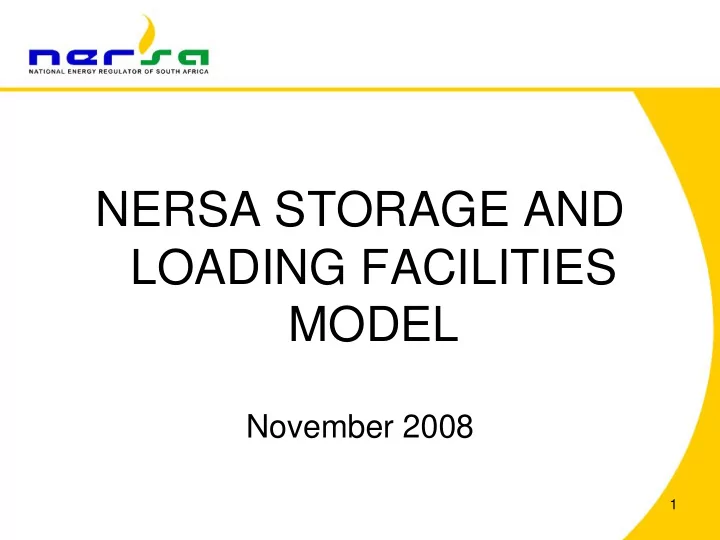

NERSA STORAGE AND LOADING FACILITIES MODEL November 2008 1
OVERVIEW • Legal Mandate • Tariff Approaches • Allowable Revenue • Assessment of Tariff Applications • Questions and Discussions 2
LEGAL MANDATE • Section 4 (f) • The Authority must …set or approve tariffs and charges in the manner prescribed by regulation • Section 28 (1) • The Authority must set as a condition of license the tariffs to be charged by a licensee in the operation of a petroleum pipeline and approve the tariffs or storage facilities and loading facilities • Regulation 5 (2) • The provisions of regulations 4(2), 4(3), 4(4), 4(5), 4(6), 4(7) and 4(9) apply, subject to the changes required by the context, to the approval of tariffs for loading and storage facilities 3
TARIFF APPROACHES • Licensee / Applicant – Selects own methodology to arrive at proposed tariff – Supplies detailed information with tariff application initially – Later completion of Regulatory Reporting should reduce burden • The Energy Regulator – Assesses application against NERSA’s methodology • Rate of return determined by WACC • Ke calculation by CAPM / any other appropriate model • Regulation 4(5) 4
ALLOWABLE REVENUE Allowable Revenue = (RAB x WACC) + E + T + D ± C Where: RAB = Regulatory Asset Base WACC = effective weighted average cost of capital E = maintenance and operating expenses T = notional tax expenses D = Depreciation C = Claw back adjustment (to correct for differences between actual and forecasts in formula elements) 5
INFORMATION REQUIRED • Regulatory Asset base (RAB) • Depreciation (D) • Operating Expenses (E) • Corporate Tax Rate (T) • Claw back adjustments (C) • Weighted average Cost of Capital (WACC) 6
REGULATORY ASSET BASE • The Regulatory Asset Base (RAB) RAB = (V – d) + w • V = historical cost or “trended original cost” (TOC) of used and usable property, plant, vehicles and equipment up to the commencement of the tariff period under review • d = accumulated depreciation • w = net working capital 7
REGULATORY ASSET BASE The Regulatory Asset Base must be valued using: “inflation adjusted historical cost” (Regulation 4(6)(e) 8
WACC ⎡ ⎤ ⎡ ⎤ ⎛ ⎞ ⎛ ⎞ E Dt = + ⎜ ⎟ ⎜ ⎟ WACC * Ke * Kd ⎢ ⎥ ⎢ ⎥ + + ⎝ ⎠ ⎝ ⎠ ⎣ ⎦ ⎣ ⎦ Dt E Dt E Where: WACC = Weighted average cost of capital E = equity Dt = debt Ke = the cost of equity (real) derived from the Capital Asset Pricing Model (CAPM) Kd = the cost of debt (real) 9
COST OF EQUITY (Ke) Cost of Equity (Ke) The cost of equity must be determined using the capital asset pricing model and the following formula - Ke = Risk free rate + (Market Risk Premium + Country Risk Adjustment) * β • Market Risk Premium = Market Premium – Risk free rate • Country Risk adjustment is for assets outside RSA β = ‘beta’, the systematic risk parameter • (Details in documents) 10
COST OF DEBT (real) Expected cost of debt (Kd) The Real Cost of debt is calculated using the following formula: + 1 Kdnom − 1 + 1 CPI • The actual estimated real cost of debt percentage subject to reasonable tests. • The Cost of Debt = (Actual Debt funding the RAB) * (the real interest rate) 11
OPERATIONAL EXPENSES Operational Expenditure (E) • Expenses are operating and maintenance expenses. ( categorised in Regulatory Reporting Manual (RRM) Volume 4. Principles regarding Expenses • See write up 12
TAXATION Taxation (T) • estimated accounting (corporate) tax expense for regulated activity • Adjustment in next tariff period for over/under estimation • Tax penalties are not allowed. 13
CLAW BACK Claw back adjustment = VA + OEA + DCA + GA Where: VA = volume adjustment OEA = Operational Expenditure adjustment DCA = debt cost adjustment GA = general adjustment for any remaining differences between projected Allowable Revenue and actual Allowable Revenue (not resulting from efficiency gains) 14
Allowable Revenue = (RAB x WACC) + E + T + D ± C Next translate Allowable Revenue into tariffs How? 15
CALCULATE TARIFF Cents per litre per Tariff Calculation day Total Allowable Revenue (R) 5,057,451 A Total litres per day (Litre) 210,000 B Total operating days 365 C Total Litre days (litres for full year) 76,650,000 D=(B*C) Tariff per litre per day (cents) 6.60 (A*100)/D 16
Tariff issues • One part or two part tariff? • Notice periods (for storage and discharge of slugs)? • Penalties for operator and client if delivery/discharge times not met? • Product quality • other 17
18 Questions and Discussion
19 THANK YOU
Recommend
More recommend